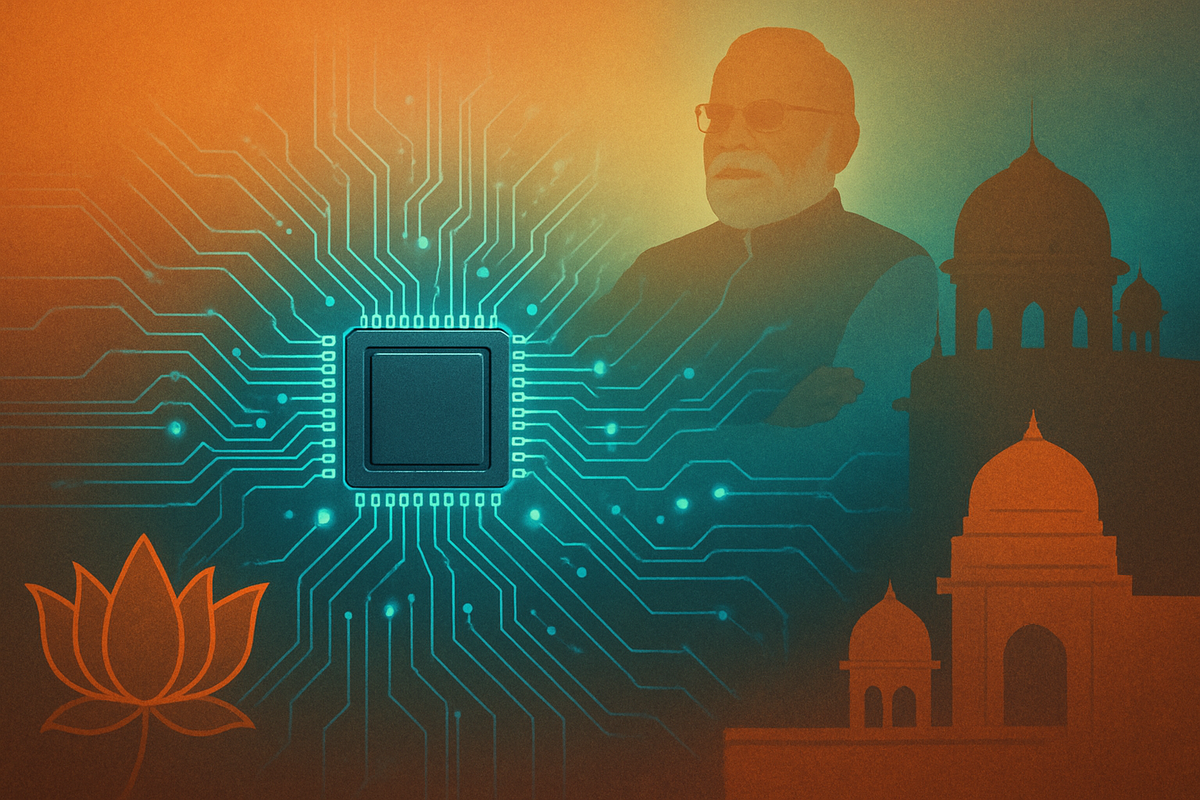
New Delhi, India – October 1, 2025 – India is rapidly transforming its technological landscape, aggressively pursuing its ambition to become a global hub for semiconductor manufacturing. Driven by Prime Minister Narendra Modi's visionary leadership and substantial governmental backing, the nation is transitioning from an aspiring participant to a significant player in the global chip race. As of late 2025, tangible outcomes are beginning to materialize, with the first "Made-in-India" chips rolling off production lines, signaling a new era of technological self-reliance and global supply chain resilience.
This monumental push is set to redefine India's economic trajectory, promising to reduce its heavy reliance on foreign chip imports and create a high-tech ecosystem that generates thousands of skilled jobs. The strategic importance of semiconductors, often referred to as the "new oil," cannot be overstated, and India's proactive stance is poised to have immediate and far-reaching implications for both its domestic industries and the global technology market.
From Vision to Fabrication: India's Semiconductor Journey Accelerates
Prime Minister Narendra Modi's "Viksit Bharat" (Developed India) by 2047 roadmap places the semiconductor sector at its core, aiming for India to become a major producer of chips that power everything from smartphones to spacecraft. His "Chip to Ship" philosophy underscores a comprehensive goal for indigenous manufacturing, emphasizing that everything from design to final product should originate within India's borders. This vision is a direct response to global supply chain vulnerabilities exposed in recent years and a strategic move to leverage India's vast talent pool, which already accounts for 20% of the world's semiconductor design engineers.
The cornerstone of this ambitious endeavor is the India Semiconductor Mission (ISM), launched in 2021 with an initial outlay of ₹76,000 crore (approximately $9.2 billion). The ISM provides a robust policy framework and financial incentives designed to attract both domestic and international investment in semiconductor and display manufacturing. Key initiatives include the "Semicon India Program," offering fiscal support of up to 50% of project costs for setting up fabrication plants (fabs), display fabs, and Assembly, Testing, Marking, and Packaging (ATMP) or Outsourced Semiconductor Assembly and Test (OSAT) facilities. Additionally, Production-Linked Incentive (PLI) and Design Linked Incentive (DLI) schemes are in place to bolster both manufacturing and indigenous design capabilities.
As of August 2025, the ISM has approved ten projects with a cumulative investment of approximately ₹1.60 lakh crore (around $19.3 billion) across six states. These projects encompass a diverse range of activities, from high-volume fabrication units and 3D heterogeneous packaging to compound semiconductors (such as silicon carbide) and OSAT facilities. A significant milestone was achieved in October 2025 with Kaynes SemiCon (NSE: KAYNES) on track to deliver India's first packaged semiconductor chips from its OSAT facility in Sanand, Gujarat, following successful qualification testing in September. Concurrently, Tata Electronics, in partnership with Powerchip Semiconductor Manufacturing Corporation (PSMC) (TWSE: 2344), is set to launch India's first commercially produced "Made-in-India" chip from its fabrication plant in Dholera, Gujarat, also anticipated between September and October 2025, backed by a substantial ₹91,000 crore (approximately $10.9 billion) investment from Tata Group. Furthermore, Micron Technology (NASDAQ: MU) is expected to roll out its first "Made-in-India" chips from its ATMP plant by early 2025, and CG Semi (part of CG Power and Industrial Solutions Limited (NSE: CGPOWER)) inaugurated an OSAT Pilot Line Facility in August 2025, with commercial output projected for 2026-27. India's indigenous capabilities were also highlighted at Semicon India 2025 with the showcasing of ISRO's Vikram Microprocessor, the nation's first fully home-grown 32-bit chip designed for launch vehicle environments.
International collaborations have been pivotal, with India formalizing Memoranda of Understanding (MoUs) with the USA, European Union, Japan, and Singapore to strengthen its semiconductor ecosystem. The recent Semicon India 2025 event, held in New Delhi in September, further solidified these partnerships, resulting in 12 new MoUs aimed at enhancing product development, service capabilities, and skill enhancement. The immediate implications are clear: a substantial portion (approximately 97%) of the allocated funding for chip production has already been committed, and India's semiconductor market, valued at US$38 billion in 2023, is projected to reach US$45-50 billion by the end of 2025 and an impressive US$100-110 billion by 2030, reflecting strong investor confidence and rapid implementation. This growth is expected to generate 35,000 high-quality direct jobs and 100,000 indirect employment opportunities, with approved projects forecasted to create over one million additional skilled jobs by 2030.
Corporate Fortunes in the Silicon Frontier: Winners and Challengers Emerge
India's aggressive foray into semiconductor manufacturing is poised to reshape corporate strategies and market dynamics, creating clear beneficiaries and presenting new challenges for companies across the global technology spectrum. As of October 2025, a diverse array of Indian and international public companies are either directly investing in or adapting their business models to leverage this burgeoning ecosystem.
Among the most significant Indian beneficiaries is Tata Electronics, a pivotal player in establishing India's first mega semiconductor fabrication plant in Dholera, Gujarat. In partnership with Taiwan's Powerchip Semiconductor Manufacturing Corporation (PSMC) (TWSE: 2344), this venture represents a massive ₹91,000 crore (approximately $11 billion) investment, with the first chips anticipated by October 2025. Tata's strategy involves becoming an integrated player in both front-end (fabrication) and back-end (assembly, test, packaging) manufacturing, diversifying the extensive Tata Group (NSE: TATASTEEL, etc.) portfolio into a high-tech, strategically vital sector. Similarly, CG Power and Industrial Solutions Limited (NSE: CGPOWER) has entered the semiconductor sector through its subsidiary CG Semi Pvt Ltd, forming a joint venture with Japan's Renesas Electronics Corporation and Thailand's Stars Microelectronics to set up an OSAT facility in Sanand, Gujarat. This move diversifies CG Power's traditional electrical engineering business into high-growth semiconductor packaging and testing, supported by substantial government subsidies. Kaynes Technology India (NSE: KAYNES), an existing electronics manufacturing services (EMS) provider, is also expanding its capabilities with a semiconductor ATMP unit in Sanand, Gujarat, expected to produce 6.3 million chips per day by October 2025, catering to a broad spectrum of industries from industrial to automotive and telecom.
Beyond direct manufacturing, India's robust talent pool is a boon for IT services and design companies. Firms like HCL Technologies (NSE: HCLTECH), through its joint venture with Foxconn (TWSE: 2354), are venturing into manufacturing with a new facility near Jewar Airport. Simultaneously, Wipro (NSE: WIPRO), Infosys (NSE: INFY), Tata Elxsi (NSE: TATAELXSI), and specialized design firms like MosChip Technologies (NSE: MOSCHIP) and Cyient (NSE: CYIENT) are well-positioned to benefit from increased demand for chip design, verification, embedded software, and related engineering services. Infosys's acquisition of semiconductor design firm InSemi and Wipro's foundry deal with UMC exemplify the deepening engagement of Indian IT giants in this space. Even Bharat Electronics Ltd (NSE: BEL), a defense electronics leader, is set to benefit from the government's push for indigenous manufacturing, particularly for strategic applications.
On the international front, Micron Technology (NASDAQ: MU) stands out as a significant early investor, constructing a $2.75 billion (₹24,000 crore) ATMP facility in Sanand, Gujarat, with commercial production slated for early 2025. This move allows Micron to diversify its global supply chain, mitigate geopolitical risks, and tap into India's expanding domestic electronics market. Equipment suppliers like Lam Research (NASDAQ: LRCX), a leader in chipmaking equipment, have announced plans to invest ₹10,000 crore (approximately $1.2 billion) in Bengaluru to scale India's supply chain operations. Even ASML Holding NV (NASDAQ: ASML), the world's biggest supplier of lithography equipment, has signaled its dedication to supporting India's innovation hub ambitions, laying groundwork for future growth as India's manufacturing capabilities mature. Furthermore, fabless design giants like Qualcomm (NASDAQ: QCOM) and Advanced Micro Devices (AMD) (NASDAQ: AMD) are leveraging India's "extraordinary talent base" for semiconductor design, with AMD announcing a $400 million investment plan in India.
While the primary aim is capacity creation, companies that fail to engage or adapt to India's burgeoning semiconductor ecosystem may face long-term challenges. Firms overly reliant on existing concentrated supply chains, particularly smaller, specialized foundries outside India, might experience a gradual erosion of market share as global electronics manufacturers diversify their procurement to India. Similarly, companies unwilling to invest in India or adapt to local conditions risk missing out on significant growth opportunities within one of the world's fastest-growing electronics markets. India's push is not just about manufacturing chips; it's about building a comprehensive, self-reliant ecosystem, and those who align with this vision are best positioned to thrive in the evolving global semiconductor landscape.
A New Geopolitical Chip: Wider Implications and Global Realignments
India's determined push to become a global chipmaking hub, solidified by substantial progress as of October 2025, carries profound wider significance, aligning with and influencing several critical global industry trends and geopolitical realignments. This strategic endeavor is not merely about economic growth; it's about securing technological sovereignty, diversifying global supply chains, and establishing India as a pivotal player in the high-stakes world of advanced technology.
This initiative directly addresses the imperative for supply chain diversification and resilience, a lesson starkly highlighted by the COVID-19 pandemic and escalating geopolitical tensions. With the global semiconductor supply chain heavily concentrated in East Asia, nations worldwide are seeking to de-risk by building domestic or allied manufacturing capacities. India is positioning itself as a credible alternative, aiming to create an end-to-end ecosystem from design to packaging. This move offers global tech giants a much-needed option to mitigate risks associated with over-reliance on any single region. Furthermore, semiconductors have become strategic assets, crucial for national security and economic power, fueling a trend of techno-nationalism. India's ambition is a clear manifestation of this, aiming to reduce dependence on foreign imports for critical technologies that power everything from AI and 5G to defense systems. The surging global demand for chips, projected to reach nearly $700 billion in 2025 and potentially $1 trillion by 2030, provides a robust market for India's emerging capacity.
The ripple effects on competitors and partners are already evident. Global giants like Micron Technology (NASDAQ: MU), Advanced Micro Devices (AMD) (NASDAQ: AMD), and Lam Research (NASDAQ: LRCX) are actively investing in India, diversifying their manufacturing and R&D footprints. While Taiwan's TSMC (TWSE: 2330, NYSE: TSM) and South Korea's Samsung Electronics (KRX: 005930) remain dominant in advanced fabrication, India offers a new avenue for global supply chain restructuring. India's efforts also intensify competition with China, which has long dominated semiconductor manufacturing. As the U.S. continues to impose restrictions on China's access to advanced chip technology, India aims to build indigenous capacity, potentially challenging China's long-term lead, albeit with a focus on incremental growth, starting with mature nodes. Moreover, India is increasingly viewed as a strategic partner by the U.S. and EU in reshaping the global chip ecosystem, aimed at countering concentrated supply chains and fostering a more multi-polar industry landscape. Japan, with its strengths in equipment and raw materials, has also emerged as a key collaborator.
India's semiconductor push is underpinned by a robust regulatory and policy framework. The "Semicon India Programme" offers substantial financial support, including a 50% capital subsidy for fabs, with states adding another 25%, bringing the total subsidy to an attractive 75%. Crucially, these subsidies are released during construction, accelerating project timelines. Production Linked Incentive (PLI) and Design-Linked Incentive (DLI) schemes further bolster domestic manufacturing and indigenous intellectual property development. The government has streamlined clearances and is investing in infrastructure, including addressing the high energy and ultra-pure water demands of fabs with a focus on sustainable practices. Historically, India's journey draws parallels with the "East Asian Tigers" – Japan, South Korea, and Taiwan – which successfully built their semiconductor industries through strategic government intervention and sustained investment. While facing similar challenges like capital intensity and talent shortages, India aims to learn from these precedents, potentially avoiding a heavy reliance on foreign providers by developing robust indigenous capacity, akin to aspects of China's "Made in China 2025" but with a distinct emphasis on self-reliance and global collaboration.
The Road Ahead: Opportunities, Challenges, and a Resilient Future
As India solidifies its foundation in semiconductor manufacturing, the road ahead presents a dynamic landscape of immense opportunities, strategic adaptations, and persistent challenges. In the short term, the successful rollout of the first "Made-in-India" chips by late 2025 from ventures like Tata Electronics and Kaynes SemiCon (NSE: KAYNES) will be a critical milestone, validating the nation's strategic push. The focus will remain on the timely execution and efficient scaling of approved fabrication plants and ATMP/OSAT facilities, which are expected to drive the market from an estimated US$45-50 billion by the end of 2025.
Looking further out, India's long-term vision aims for its semiconductor market to reach an impressive US$100-110 billion by 2030, securing a significant share of the projected US$1 trillion global market. The nation aspires to be among the top five semiconductor manufacturing nations by 2029, emerging as a reliable alternative hub for global technology supply chains, thereby reducing geopolitical risks for multinational corporations. This ambitious trajectory will be guided by continued strategic adaptations under the India Semiconductor Mission (ISM), leveraging Production-Linked Incentive (PLI) and Design Linked Incentive (DLI) schemes, and focusing on specialized niches like analog, power semiconductors, and OSAT. International collaborations with the US, Japan, EU, and Singapore, alongside robust state-level support, will remain crucial for technology transfer and investment attraction. The ongoing development of a skilled workforce, with plans to train tens of thousands of engineers, is paramount to sustain this growth. Market opportunities will continue to surge from booming domestic demand driven by rapid digitization, emerging technologies like 5G, AI, IoT, and electric vehicles, as well as strategic sectors such as aerospace and defense.
However, significant challenges persist. The exorbitant capital expenditure required for establishing fabrication units (US$5-7 billion per fab) remains a formidable barrier. India also faces an underdeveloped local supply chain for critical raw materials, high-purity gases, and specialty chemicals, necessitating continued reliance on imports. A shortage of highly specialized manufacturing talent, global competition from established hubs, and the need for robust infrastructure (e.g., uninterrupted 24/7 power, ultra-pure water) are hurdles that require sustained focus and investment. Potential scenarios range from India becoming a specialized hub for design and OSAT, evolving into a reliable alternative manufacturing destination for mature nodes, to ultimately becoming a significant or even a "full-stack semiconductor nation" with end-to-end capabilities. The path chosen will depend on sustained commitment, strategic flexibility, and the ability to overcome these inherent complexities.
Conclusion: India's Moment in the Silicon Sun
India's journey towards becoming a global chipmaking hub represents a monumental strategic shift, driven by a clear vision and unwavering governmental support. The key takeaways from this ambitious endeavor are manifold: the Indian government's commitment, evidenced by the ISM and various incentive schemes, is the primary catalyst; the focus extends beyond mere manufacturing to building a holistic ecosystem encompassing design, fabrication, and packaging; a large and expanding domestic market provides a natural impetus for local production; and strategic global interest from major international players underscores confidence in India's potential. Crucially, India's robust pool of design engineers provides a significant competitive advantage.
Moving forward, the Indian semiconductor market is poised for a rapid growth phase, transitioning from policy formulation to active implementation and execution. This period of dynamic expansion, fueled by increasing private and foreign investments, signals a strong positive trajectory. Public-private partnerships will be critical to navigating the complexities and capitalizing on the opportunities. While the sector is still in its nascent stages regarding end-to-end manufacturing, the strategic emphasis on specific verticals like design and ATMP/OSAT is expected to yield quicker results and build foundational capabilities for future advancements.
For investors, the coming months will be crucial for monitoring several key indicators. The timely execution and efficient scaling of approved fabrication plants and ATMP/OSAT facilities, such as Micron Technology's (NASDAQ: MU) plant in Gujarat and Tata Electronics' ventures, will be paramount. Progress in establishing local capabilities for raw materials, specialty chemicals, and equipment manufacturing will signify a strengthening ecosystem. The effectiveness of talent development programs, continuity of government policies, and stability of the regulatory environment will be vital for attracting and retaining long-term investments. Further significant commitments from global and domestic players, alongside the successful commercialization and adoption of India's first indigenous chips, will be strong performance indicators. Finally, shifts in the global geopolitical landscape could either create more opportunities for India (e.g., accelerated supply chain diversification) or introduce new challenges, making it a critical factor for investors to watch. India's moment in the silicon sun has arrived, promising a lasting impact on its economic future and the global technology landscape.
This content is intended for informational purposes only and is not financial advice.





